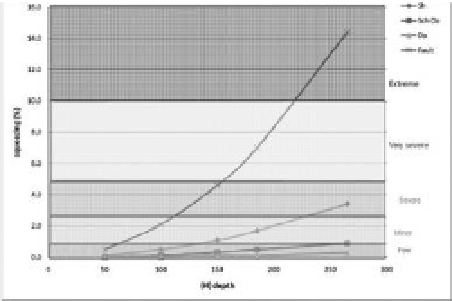Environmental Engineering Reference
In-Depth Information
- The F formation, corresponding to the possible
faults (which were not detected in any of the bor-
ings) shows squeezing behaviour when encoun-
tered deeper than 100 m. however, it must be
noticed that according to the geological model
described in paragraph 2 the inferred faults are
hardly thicker than 10 m and, therefore, are not
suitably modelled in the hoek-Marinos scheme
where it is considered that all rock mass is homo-
geneous with de parameters of the Fault.
as a general conclusion, given the stratigra-
phy along the tunnel established in Figure 3, the
simplified analysis by hoek-Marinos doesn't indi-
cate foreseeable squeezing problems along the
tunnel. however, the Flac-3D finite difference
analyses will be more accurate to model the rock
mass behaviour to properly design adequate sup-
port means of the tunnel galleries.
Figure 14. Deformation potential of the geotechnical
units at different tunnel overburden.
Table 2. Range of potential problems, according to
hoek (2002).
class
Deformation ε (%)
Potential problems
ReFeRences
1
Few problems
ε ≤ 1
Bieniawski, Z.T. 1978. Determining rock mass
deformability; experience from case histories. int J. of
Rock Mech & Min. scio, Vol 15, pp 237-247.
cai, M., P.k. kaiser, Y. Tasaka and M. Minami. 2006.
Determination of residual strength parameters of
jointed rock masses using the Gsi system.
hoek, e., P. Marinos and M. Benissi. 1998. applicability
of the geological strength index (Gsi) classification
for very weak and sheared rock masses. The case of
the athens schist Formation.
kayabashi, a. and Gokceoglu, c. et al. 2003. estimating
the deformation modulus of rock masses; a
comparative study. int. J. of Rock Mech. & Min. sci.,
Vol 40 pp 55-63.
Marinos, P., e. hoek and V. Marinos. 2006. Variability of
the engineering properties of rock masses quantified
by the geological strength index: the case of ophiolites
with special emphasis on tunneling.
Marinos P. and e. hoek. 2001. estimating the
geotechnical properties of heterogeneous rock masses
such as Flysch.
steiakakis c. and o. Verroios. september 2005.
Rock mass classification system (Gsi) misuses in
problematic rocks. Ricardo Z. Bieniawski. april 2003.
new tendencies in rock mass characterization.
2
Minor squeezing
1 < ε ≤ 2,5
3
severe squeezing
2,5 < ε ≤ 5
4
5 < ε ≤ 10
Very severe squeezing
5
ε > 10
extreme squeezing
The figure 14 shows a sensitivity analysis of the
hoek criterion for the geotechnical parameters
established in paragraph 4 for different tunnel
depths.
6
conclUsions
The investigations carried out to appraise the
deformation potential of a deep tunnel in this
ophiolitic complex have shown that:
- Do and sch-Do formations do not show squeez-
ing problems even at the maximum tunnel
depth.
- sh formation shows only minor squeezing prob-
lems when encountered in the tunnel deeper
than 150 m.


















